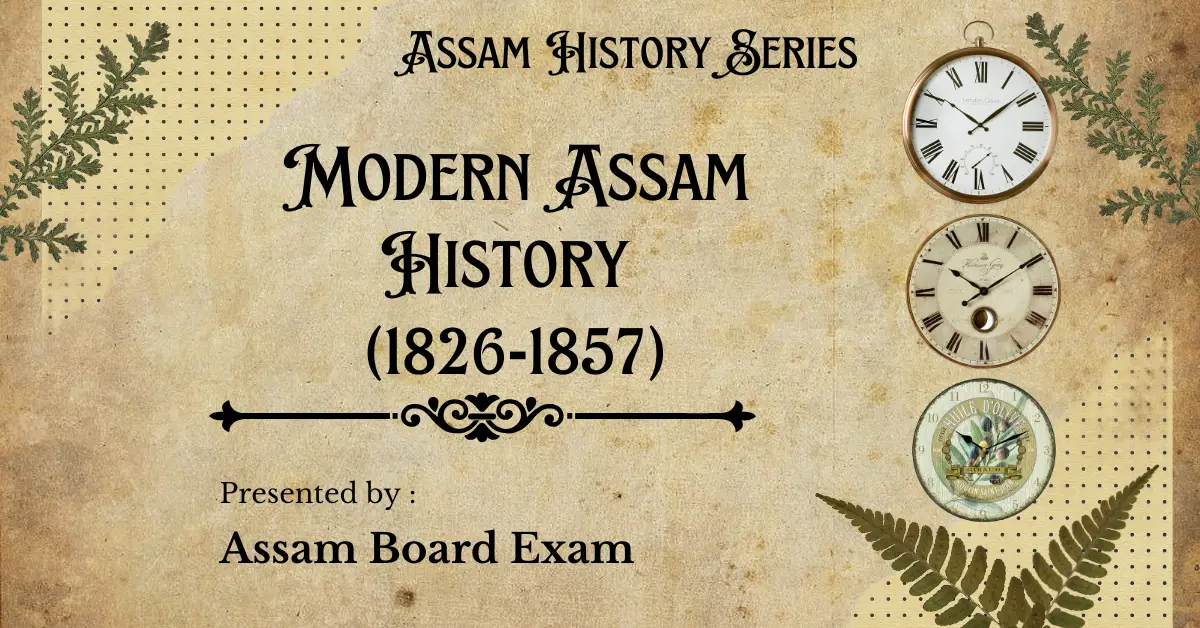Discover the critical events of Modern Assam history, from the Treaty of Yandabo to the Revolt of 1857. Explore the transition from Burmese to British rule and the series of uprisings that defined Assam’s resistance.
Table of Contents
1. Treaty of Yandabo (1826): End of Burmese Rule
The Treaty of Yandabo concluded the First Anglo-Burmese War and ended Burmese control over Assam.
- Terms of the Treaty:
- Burma renounced all claims to Assam, Cachar, and Jayantia.
- No formal cession to the British; it left a political vacuum.
- British Intervention:
- David Scott, the Agent to the Governor-General, restored local rulers in neighboring regions like Cachar, Jayantia, and Manipur while consolidating British influence.
2. Annexation of Lower and Upper Assam
Lower Assam (1828)
The British permanently annexed Lower Assam on March 7, 1828.
Upper Assam (1833–1838)
- Initially, the British restored Purandar Singha, an Ahom prince, under the Treaty of Guwahati (1833).
- His administration failed, leading to the complete annexation of Upper Assam in 1838.
3. Annexation of Cachar
Key Events:
- Treaty of Badarpur (1824): Govinda Chandra, the ruler of Cachar, allied with the British.
- Tularam Senapati: Asserted authority in North Cachar.
- Assassination of Govinda Chandra (1830): He was killed, allegedly by Gambhir Singh of Manipur, leaving no male heir.
British Annexation:
- Southern Cachar was annexed in 1832.
- Tularam revolted but was suppressed, ceding some territory.
- After his death in 1850, North Cachar was fully annexed in 1854.
4. Annexation of Jayantia
- Ram Singh’s Death (1832): The ruler was succeeded by his 17-year-old grandnephew, Rajendra Singh.
- British Annexation: Jayantia was annexed in 1835 due to administrative challenges and British expansionist policies.
5. Anti-British Uprisings in Assam
First Uprising (1828)
- Leader: Dhanjoy Borgohain, supported by Gomdhar Konwar, an Ahom prince.
- Outcome: The rebellion was crushed, and Gomdhar was imprisoned.
Second Uprising (1829)
- Leaders: Dhanjoy Borgohain, Peali Phukan, Rupchand Konwar, and others.
- Outcome: Peali Phukan and Jeuram Barua were executed, while others were imprisoned.
Khasi Resistance (1828–1832)
- Leader: Teerut Singh led the Khasi rebellion.
- Outcome: The rebellion ended with a peace agreement in 1832 under the British Subsidiary Alliance system.
6. Revolt of 1857 in Assam
The Revolt of 1857 saw local Assamese leaders challenging British authority.
Maniram Dewan’s Role
- Plan: Maniram Dewan urged Kandarpeswar Singha, an Ahom prince, to lead a rebellion.
- Execution: Maniram sought support from sepoys in Assam, promising rewards.
British Response
- Major Hannay intercepted the plans, arrested key leaders, and suppressed the rebellion.
- Outcome:
- Maniram Dewan and Peali Barua were hanged.
- Kandarpeswar Singha was pardoned but kept under surveillance.
7. Legacy of Modern Assam History
The 19th century was a turning point for Assam:
- The annexations of Assam, Cachar, and Jayantia solidified British control.
- Uprisings like those of Dhanjoy Borgohain, Peali Phukan, and Maniram Dewan symbolized Assamese resistance.
- The region became a key administrative center under colonial rule, with Shillong emerging as the British headquarters.
Conclusion
From the Treaty of Yandabo to the Revolt of 1857, Assam’s history during the 19th century reflects a complex interplay of power, resistance, and adaptation. The courage of Assamese leaders and the transitions of this era continue to inspire and define the region’s historical identity.
Follow Us
Stay connected and updated with our latest offerings by following us on Youtube
.



